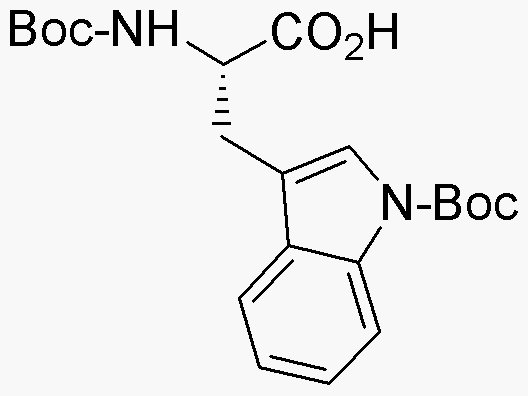Na-Boc-Nin-Boc-L-tryptophan is widely utilized in research focused on:
- Peptide Synthesis: This compound serves as a key building block in the synthesis of peptides, particularly for those requiring protected amino acids. Its Boc (tert-butoxycarbonyl) groups provide stability during the synthesis process.
- Drug Development: Researchers leverage its properties to develop novel pharmaceuticals, especially in the field of neuropharmacology, where tryptophan derivatives play a crucial role in serotonin production.
- Bioconjugation: The compound is used in bioconjugation techniques, allowing for the attachment of biomolecules to surfaces or other molecules, which is essential in creating targeted drug delivery systems.
- Research in Neuroscience: Its application in studies related to neurotransmitter pathways helps scientists understand mood regulation and the impact of tryptophan on mental health.
- Protein Engineering: This compound aids in the design of proteins with specific functionalities, enhancing the development of enzymes and therapeutic proteins in biotechnology.
General Information
Properties
Safety and Regulations
Applications
Na-Boc-Nin-Boc-L-tryptophan is widely utilized in research focused on:
- Peptide Synthesis: This compound serves as a key building block in the synthesis of peptides, particularly for those requiring protected amino acids. Its Boc (tert-butoxycarbonyl) groups provide stability during the synthesis process.
- Drug Development: Researchers leverage its properties to develop novel pharmaceuticals, especially in the field of neuropharmacology, where tryptophan derivatives play a crucial role in serotonin production.
- Bioconjugation: The compound is used in bioconjugation techniques, allowing for the attachment of biomolecules to surfaces or other molecules, which is essential in creating targeted drug delivery systems.
- Research in Neuroscience: Its application in studies related to neurotransmitter pathways helps scientists understand mood regulation and the impact of tryptophan on mental health.
- Protein Engineering: This compound aids in the design of proteins with specific functionalities, enhancing the development of enzymes and therapeutic proteins in biotechnology.
Documents
Safety Data Sheets (SDS)
The SDS provides comprehensive safety information on handling, storage, and disposal of the product.
Product Specification (PS)
The PS provides a comprehensive breakdown of the product’s properties, including chemical composition, physical state, purity, and storage requirements. It also details acceptable quality ranges and the product's intended applications.
Certificates of Analysis (COA)
Search for Certificates of Analysis (COA) by entering the products Lot Number. Lot and Batch Numbers can be found on a product’s label following the words ‘Lot’ or ‘Batch’.
Numéro de catalogue
Numéro de lot/série
Certificates Of Origin (COO)
This COO confirms the country where the product was manufactured, and also details the materials and components used in it and whether it is derived from natural, synthetic, or other specific sources. This certificate may be required for customs, trade, and regulatory compliance.
Numéro de catalogue
Numéro de lot/série
Safety Data Sheets (SDS)
The SDS provides comprehensive safety information on handling, storage, and disposal of the product.
DownloadProduct Specification (PS)
The PS provides a comprehensive breakdown of the product’s properties, including chemical composition, physical state, purity, and storage requirements. It also details acceptable quality ranges and the product's intended applications.
DownloadCertificates of Analysis (COA)
Search for Certificates of Analysis (COA) by entering the products Lot Number. Lot and Batch Numbers can be found on a product’s label following the words ‘Lot’ or ‘Batch’.
Numéro de catalogue
Numéro de lot/série
Certificates Of Origin (COO)
This COO confirms the country where the product was manufactured, and also details the materials and components used in it and whether it is derived from natural, synthetic, or other specific sources. This certificate may be required for customs, trade, and regulatory compliance.


